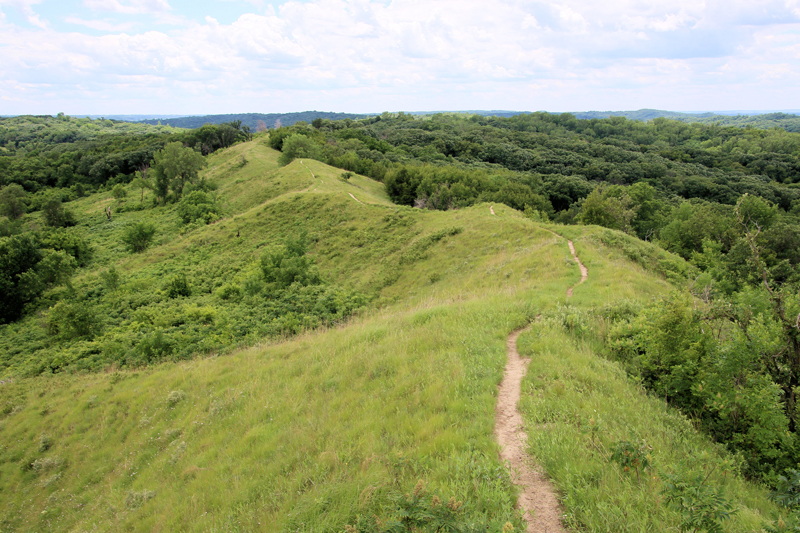
Parallel to the Missouri Alluvial Plain, along Iowa’s western border, is the Loess Hills, unquestionably the most unique landform of this state. Created by wind-blown loess from the Missouri River floodplain, deposits ranging from 18 to 90 meters in depth form steep, prominent ridges, which rise abruptly above the floodplain to the west. The bluffs and ridges of these hills of loess extend eastward for distances of three to twenty miles. Viewed from above, the landscape has a corrugated appearance of alternating waves and troughs, and the hills are generally sharp-featured, with narrow-crested ridges that are intersected with side-spurs and steep side-slopes. While the western boundary is typically very abrupt, the eastern boundary is not well defined, with the hills gradually merging with the rolling landscape of the Southern Iowa Drift Plain. The hills’ silt deposits are loosely compacted and porous, light-weight, and very cohesive when dry; characteristics that enable loess to maintain nearly vertical slopes when deeply eroded or cut through with equipment to create roadways. Steeper slopes often have a terraced or step-like appearance. Historically, the northern portion of this region was nearly completely covered by short-grass prairie, with a mix of prairie, bur oaks, and cedars more prevalent in the southern reaches. Today, primarily from a lack of fire, savanna and woodland cover a much higher percentage of the Loess Hills, especially on moister northerly and east-facing slopes. While the steepness of the Loess Hills has typically made row-crop agriculture difficult, within the last decade tens of thousands of acres of pastures, prairies, and hayfields have been converted to now raise corn and soybeans.
Broken Kettle Bird Conservation Area (BCA), Loess Hills Bird Conservation Area, and Lower Loess Hills Bird Conservation Area together include nearly 81,000 hectares of the Loess Hills region. Represented within these three BCAs is some of the very best existing bird habitat, including The Nature Conservancy’s Broken Kettle Grasslands, Loess Hills Wildlife Area, Loess Hills Forest, Lewis and Clark State Park, and Waubonsie State Park. Declining grassland nesting birds that can be found here include Northern Bobwhite, Bell’s Vireo, Field Sparrow, Grasshopper Sparrow, Dickcissel, Bobolink, and both meadowlark species. Savanna species, including Iowa’s Endangered Barn Owl, Red-headed Woodpecker, Baltimore Oriole, and Orchard Oriole all nest here. As woodland is increasing, more woodland nesting birds are found in this region, such as Yellow-bellied Sapsucker, Acadian Flycatcher, Wood Thrush, Blue-winged Warbler, Louisiana Waterthrush, Kentucky Warbler, and Yellow-breasted Chat. Both Blue Grosbeak and Western Kingbird are common in this particular region. Loess Hills is one of the most important remaining strongholds for nesting Eastern Whip-poor-wills and Chuck-will’s-widow. It especially is well known for its spectacular raptor migrations, and no other place in the state has documented more migrating raptors than Hitchcock Nature Center (Pottawattamie County), where more than 11,000 raptors of 20+ species are recorded each fall.